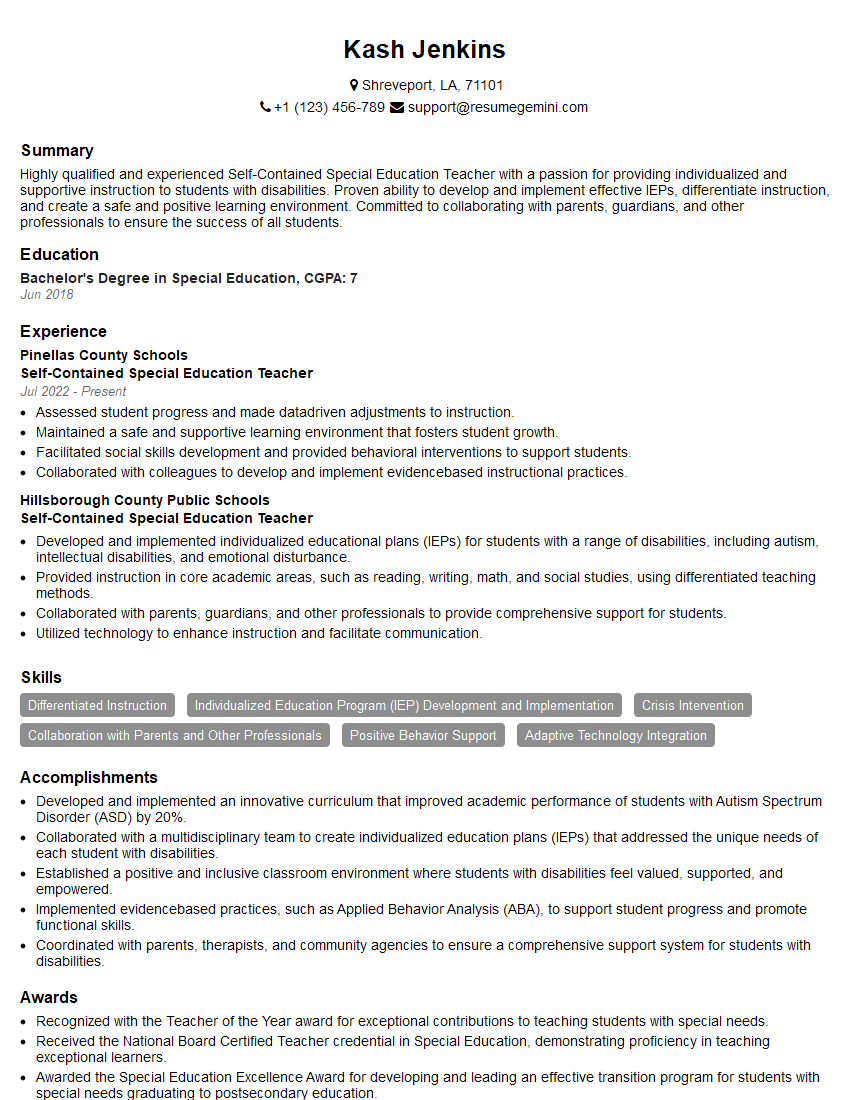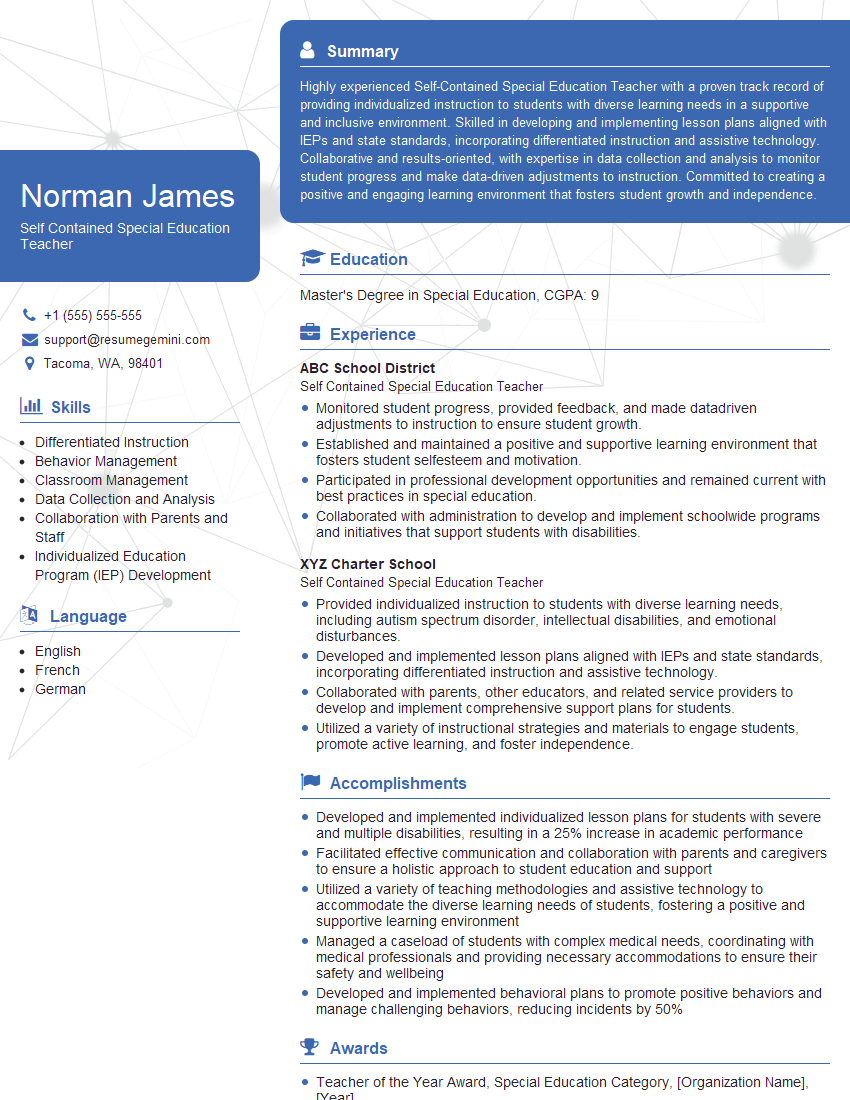Feeling lost in a sea of interview questions? Landed that dream interview for Self-Contained Special Education Teacher but worried you might not have the answers? You’re not alone! This blog is your guide for interview success. We’ll break down the most common Self-Contained Special Education Teacher interview questions, providing insightful answers and tips to leave a lasting impression. Plus, we’ll delve into the key responsibilities of this exciting role, so you can walk into your interview feeling confident and prepared.
Acing the interview is crucial, but landing one requires a compelling resume that gets you noticed. Crafting a professional document that highlights your skills and experience is the first step toward interview success. ResumeGemini can help you build a standout resume that gets you called in for that dream job.
Essential Interview Questions For Self-Contained Special Education Teacher
1. Describe the modifications and accommodations you have used in your teaching to meet the needs of students with disabilities in a self-contained special education classroom.
In my previous role as a Self-Contained Special Education Teacher, I employed a range of modifications and accommodations to cater to the diverse needs of my students with disabilities.
- Modified Assignments: I adjusted assignment lengths, complexity, and deadlines to align with students’ abilities and ensure accessibility.
- Assistive Technology: I utilized tools such as text-to-speech software, visual aids, and adaptive keyboards to support students’ learning.
2. What strategies do you use to promote positive behavior in a self-contained special education classroom?
Creating a Supportive Environment:
- Establish clear rules and expectations.
- Foster a sense of community and belonging.
Using Positive Reinforcement:
- Praise specific behaviors.
- Offer rewards and incentives.
3. How do you assess student progress and make data-driven decisions in a self-contained special education classroom?
I employ a comprehensive approach to student assessment and data-driven decision-making:
- Formal and Informal Assessments: I use standardized tests, observations, and portfolios to gather data on student performance.
- Progress Monitoring: I track student progress regularly to identify areas where additional support or adjustments are needed.
4. What is your approach to collaborating with parents and other professionals in a self-contained special education classroom?
Collaboration is crucial to student success:
- Open Communication: I maintain regular contact with parents and share updates on their child’s progress.
- Teamwork: I work closely with other professionals, such as therapists and social workers, to develop comprehensive support plans.
5. Describe how you differentiate instruction to meet the needs of students with varying abilities in a self-contained special education classroom.
Differentiated instruction is essential to ensure equity:
- Flexible Grouping: I create groups based on student needs and adjust the pace and complexity of instruction accordingly.
- Individualized Learning Plans: I develop tailored learning plans that outline specific goals and strategies for each student.
6. How do you create a safe and inclusive learning environment for all students in a self-contained special education classroom?
A safe and inclusive environment is non-negotiable:
- Respectful Interactions: I establish a classroom culture where diversity is valued and everyone’s voice is heard.
- Universal Design for Learning: I implement teaching strategies and materials that cater to a range of learners.
7. What strategies do you use to promote self-advocacy and independence in students with disabilities in a self-contained special education classroom?
Empowering students is key:
- Choice and Voice: I involve students in decision-making and encourage them to express their preferences.
- Goal Setting: I help students set realistic goals and monitor their progress towards achieving them.
8. How do you stay up-to-date on best practices and advancements in the field of special education?
Continuous learning is vital:
- Professional Development: I attend workshops, conferences, and courses to enhance my knowledge and skills.
- Collaboration with Colleagues: I engage in regular discussions and share ideas with other special education professionals.
9. What are your strengths and weaknesses as a Self-Contained Special Education Teacher?
Self-awareness and a growth mindset are essential:
- Strengths: Patience, empathy, creativity, ability to differentiate instruction.
- Weaknesses: Time management (continuously working on improving), managing large groups at times.
10. Why are you passionate about teaching students with disabilities in a self-contained special education classroom?
Passion and purpose drive me:
- Making a Difference: I find it incredibly rewarding to witness the growth and progress of students with disabilities.
- Advocacy: I am committed to creating an equitable and inclusive educational experience for all students.
Interviewers often ask about specific skills and experiences. With ResumeGemini‘s customizable templates, you can tailor your resume to showcase the skills most relevant to the position, making a powerful first impression. Also check out Resume Template specially tailored for Self-Contained Special Education Teacher.
Career Expert Tips:
- Ace those interviews! Prepare effectively by reviewing the Top 50 Most Common Interview Questions on ResumeGemini.
- Navigate your job search with confidence! Explore a wide range of Career Tips on ResumeGemini. Learn about common challenges and recommendations to overcome them.
- Craft the perfect resume! Master the Art of Resume Writing with ResumeGemini’s guide. Showcase your unique qualifications and achievements effectively.
- Great Savings With New Year Deals and Discounts! In 2025, boost your job search and build your dream resume with ResumeGemini’s ATS optimized templates.
Researching the company and tailoring your answers is essential. Once you have a clear understanding of the Self-Contained Special Education Teacher‘s requirements, you can use ResumeGemini to adjust your resume to perfectly match the job description.
Key Job Responsibilities
A Self-Contained Special Education Teacher is a highly trained professional who works with students with disabilities in a self-contained classroom. These teachers are responsible for providing a safe and supportive learning environment for their students and ensuring that they receive the individualized instruction they need to succeed.
1. Developing and Implementing Individualized Education Programs (IEPs)
Self-Contained Special Education Teachers work closely with a team of professionals to develop IEPs for their students. These IEPs outline the student’s individual needs and goals, and the services and accommodations that will be provided to help them succeed.
- Assess students’ needs and develop individualized education programs (IEPs) that outline their academic, social, and behavioral goals.
- Collaborate with other professionals, such as speech therapists, occupational therapists, and psychologists, to develop and implement appropriate interventions.
2. Providing Instruction
Self-Contained Special Education Teachers provide instruction in a variety of academic areas, including math, reading, writing, and science. They also teach social and life skills.
- Provide instruction in a variety of academic subjects, including math, reading, writing, and science.
- Use a variety of teaching methods and materials to meet the individual needs of their students.
- Provide support and guidance to students with social and behavioral challenges.
3. Managing the Classroom Environment
Self-Contained Special Education Teachers are responsible for managing the classroom environment to ensure that it is safe and supportive for all learners. This includes setting clear expectations, establishing routines, and providing positive behavior supports.
- Manage the classroom environment to ensure that it is safe, supportive, and conducive to learning.
- Establish clear rules and expectations for students.
- Provide positive behavior supports to help students learn appropriate behaviors.
4. Communicating with Parents and Other Professionals
Self-Contained Special Education Teachers communicate regularly with parents and other professionals to keep them informed about the student’s progress and to discuss any concerns or changes in the student’s IEP.
- Communicate regularly with parents and other professionals to keep them informed about the student’s progress.
- Discuss any concerns or changes in the student’s IEP with parents and other professionals.
- Participate in team meetings to discuss the student’s progress and make decisions about the student’s education.
Interview Tips
Interviewing for a Self-Contained Special Education Teacher position can be a challenging but rewarding experience. Here are a few tips to help you ace your interview:
1. Research the school and the position
Before your interview, take some time to research the school and the position you are applying for. This will help you to better understand the school’s mission and values, and the specific needs of the students you will be working with.
- Visit the school’s website and read about its mission and values.
- Look for information about the specific position you are applying for, such as the grade level and subject area.
- If possible, talk to other teachers who work at the school to get their insights on the school and the position.
2. Practice your answers to common interview questions
There are a number of common interview questions that you are likely to be asked, such as “Why do you want to teach special education?” and “What are your strengths and weaknesses as a teacher?”. Take some time to practice your answers to these questions so that you can deliver them confidently and clearly during your interview.
- Use the “STAR” method to answer interview questions. This method involves describing a Situation, Task, Action, and Result.
- For example, when answering the question “Why do you want to teach special education?”, you could use the STAR method as follows:
3. Be prepared to talk about your experience and qualifications
During your interview, you will be asked to talk about your experience and qualifications as a teacher. Be prepared to discuss your teaching philosophy, your experience working with students with disabilities, and your knowledge of special education law and best practices.
- Bring a portfolio of your work to your interview, such as lesson plans, student work samples, and letters of recommendation.
4. Ask questions
At the end of your interview, you will be given the opportunity to ask questions. This is a great time to learn more about the school, the position, and the students you will be working with. It is also a good opportunity to show the interviewer that you are interested in the position and that you have done your research.
- Some good questions to ask include:
- What are the school’s expectations for special education teachers?
- What are the challenges and rewards of teaching special education?
- What opportunities are there for professional development?
Next Step:
Now that you’re armed with interview-winning answers and a deeper understanding of the Self-Contained Special Education Teacher role, it’s time to take action! Does your resume accurately reflect your skills and experience for this position? If not, head over to ResumeGemini. Here, you’ll find all the tools and tips to craft a resume that gets noticed. Don’t let a weak resume hold you back from landing your dream job. Polish your resume, hit the “Build Your Resume” button, and watch your career take off! Remember, preparation is key, and ResumeGemini is your partner in interview success.

